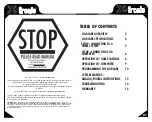
n
Motor Application Precautions
Standard Induction Motors
Low-Speed Range
The cooling fan of a standard motor should sufficiently cool the motor at the rated speed. As the self-cooling capability of
such a motor decreases with the speed, applying full torque at low speed will possibly damage the motor. Reduce the load
torque as the motor slows to prevent motor damage from overheat.
shows the allowable load characteristics for a
Yaskawa standard motor. Use a motor designed specifically for operation with a drive when 100% continuous torque is needed
at low speeds.
50
3 6
60
60
70
80
90
100
25% ED (or 15 min)
40% ED (or 20 min)
60% ED (or 40 min)
Frequency (Hz)
Continuous operation
Torque
(%)
20
Figure i.1 Allowable Load Characteristics for a Yaskawa Motor
Insulation Tolerance
NOTICE: Consider motor voltage tolerance levels and motor insulation in applications with an input voltage of over 440 V or particularly
long wiring distances.
High-Speed Operation
NOTICE: Problems may occur with the motor bearings and dynamic balance of the machine when operating a motor beyond its rated speed.
Contact the motor or machine manufacturer.
Torque Characteristics
Torque characteristics differ compared to operating the motor directly from line power. The user should have a full
understanding of the load torque characteristics for the application.
Vibration and Shock
The drive allows selection of high carrier PWM control. Selecting Closed Loop Vector control can help reduce motor
oscillation.
• Take particular caution when adding a variable speed drive to an application running a motor from line power at a constant
speed. If resonance occurs, install shock-absorbing rubber around the base of the motor and enable the Jump Frequency
function to prevent continuous operation in the resonant frequency range.
• Mechanical resonance can occur with long motor shafts and in applications such as turbines, blowers, and fans with high
inertia loads.
Audible Noise
The audible noise of the motor varies based on the carrier frequency setting. However, drive current derating may be required.
When using a high carrier frequency, audible noise from the motor is comparable to the motor noise generated when running
from line power.
Synchronous Motors
• Contact Yaskawa or a Yaskawa representative when planning to use a synchronous motor not endorsed by Yaskawa.
• Use a standard induction motor when running multiple synchronous motors simultaneously. A single drive does not have
this capability.
• A synchronous motor may rotate slightly in the opposite direction of the Run command at start depending on parameter
settings and rotor position.
• The amount of generated starting torque differs depending on the control mode and motor type. Set up the motor with the
drive after verifying the starting torque, allowable load characteristics, impact load tolerance, and speed control range.
Contact Yaskawa or a Yaskawa representative when planning to use a motor that does not fall within these specifications:
i.1 Preface
10
YASKAWA ELECTRIC TOEP C710636 11E Z1000U HVAC MATRIX Drive Quick Start Guide











































